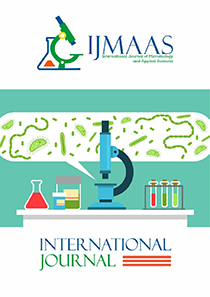Microbial Quality of Ready-To-Eat Pineapple (Ananas comosus) and Watermelon (Citrullus lanatus)
Vol 3, Issue 1, 2024
KEYWORDS
Pineapple (Ananas comosus), Watermelon (Citrullus lanatus), microbial quality, antibiotic susceptibility, food safety
Abstract
Spoilage of fruits from contamination by microorganisms through irrigation water, harvesting/processing equipment, transporting, personal handling, soil, dust and even manure is a source of concern to human existence. This study assesses the microbial quality and antibiotics sensitivity of bacteria of ready-to-eat Pineapple (Ananas comosus) and Watermelon (Citrullus lanatus) in five markets in Port Harcourt using standard microbiological techniques. Total heterotrophic bacterial count for pineapple and watermelon ranged between 1.1×105 – 1.9×106CFU/g and 1.0×104 – 8.7×106CFU/g respectively. Fungal count ranged between 1.3×103 to 7.2×104CFU/g and 1.0×103 – 4.6×104CFU/g respectively. Isolated bacteria and fungi and frequency of occurrences (%) from pineapple were Staphylococcus sp(25%), Citrobacter sp(6.3%), Proteus sp(12.5%), Salmonella sp(6.3%), Bacillus sp(18.8%), Klebsiella sp(12.5%), Escherichia coli(18.7%), and Candida sp(21.4%), Aspergillus sp(28.5%), Penicillium sp., (21.4%) and Fusarium sp(7.1%). Isolated bacteria and fungi and frequency of occurrences (%) from watermelon were Staphylococcus sp(27.2%), Proteus sp(18.2%), Bacillus sp(18.2%), Klebsiella sp(18.2%), Escherichia coli(18.2%), Candida sp(15.4%), Aspergillus sp(15.4%), Penicillium sp(38.4%), Fusarium sp(7.7%), and Mucor(23.1%). All Staphylococcus and Bacillus isolates were 100% resistant to Ampiclox, Norfloxacin, and Gentamycin. While 57.14% and 80% of Staphylococcus and Bacillus respectively was susceptible to Leofloxacin. 75% of Klebiella was susceptible to Augmentin while 75% was resistant to Amoxacillin, and Ofloxacin. 75% of Proteus was susceptible to streptomycin while all the isolates were 100% resistant to Sparfloxacin. Salmonella was 100% susceptible to Septrin, Sparfloxacin, Ciprofloxacin, Ofloxacin and 100% resistant to Augmentin, Gentamycin Nalidixic acid, and Streptomycin. Multiple antibiotics resistance (MAR) index was greater than 0.2 for all isolates. Statistical analysis showed that there were no significant differences (P>0.05) in the microbial counts between Pineapple and Watermelon. Isolated microorganisms are responsible for microbial contamination of fruits sold in the markets. This therefore calls for serious attention in creating awareness in the control of human infectious diseases associated with consumption of contaminated fruits.
Current: Vol. 4, Issue 1, 2025

Call for papers
The International Journal of Microbiology and Applied Sciences warmly welcome your valuable articles for publication.
